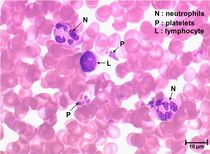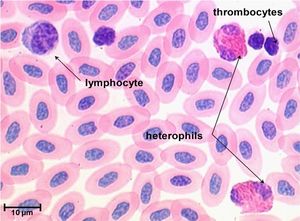Haematopoiesis - Overview
Introduction
Haematopoiesis is also known as haemopoiesis or hemopoiesis and describes the process of blood cell formation. All blood cells are derived from the initial pluripotent stem cell (PPSC) which gives rise to colony forming units (CFUs). These CFUs further differentiate to give rise to their final stage of development where they become the various forms of blood cells or those cells which migrate from the circulation into tissues, such as mast cells and macrophages.
Development
PPSC’s initially divide and differentiate into multipotential haematopoietic stem cells of one of two lineages: myeloid progenitors (granulocytes, erythroblasts, macrophages and megakaryocytes) or lymphoid progenitors (B lymphocytes, T lymphocytes and NK cells).
The development of blood cells from the haematopoietic stem cell into the final mature cell is categorised into:
- The formation of red blood cells (Erythropoiesis)
- The formation of white blood cells (Leukopoiesis)
- The formation of platelets (Thrombopoiesis)
Leukopoiesis is further classified by the lineage of the white blood cell being formed, namely:
- Formation of neutrophils, eosinophils and basophils (Granulopoiesis)
- Formation of B cells and T cells (Lymphopoiesis)
Foetal Haematopoiesis
Yolk Sac Phase
Blood islands from the mesoderm form in the yolk sac early in gestation. They provide primitive erythrocytes to support the developing embryo. These blood islands also give rise to the haematopoietic stem cells.
Haematopoiesis also occurs within the embryo at a region called the aorta-gonad-mesonephros region (AGM).
Hepatic Phase
As embryological development continues haematopoiesis shifts from the yolk sac and AGM to the foetal liver (and spleen). Haematopoietic areas form in the liver which become the main haematopoietic organ in the body. Erythropoiesis is the predominant process but some leukopoiesis occurs so the foetal liver can be considered a primary lymphoid organ.
Bone marrow phase
Haematopoiesis starts to occur in the bone marrow later in gestation, and the spleen becomes the main erythrocyte producing organ during the transitional phase from liver to bone marrow.
Haematopoiesis in Adults
Haematopoiesis occurs in bone marrow and maturation of lymphocytes in lymphoid tissues. In the bone marrow the haematopoietic cells are supported by stromal cells which generate the correct environment to induce the growth and development of the different blood cell types.
Lineages
The lineage of a blood cell is based on the multipotential stem cell that the cell is derived from.
- Lymphoid cells (lymphocytes) are derived from the multipotential lymphoid stem cells
- Cells derived from the multipotential myeloid stem cells are either:
- Erythroid lineage (forming erythrocytes) or
- Myeloid lineage (forming neutrophils, monocytes, macrophages, eosinophils, basophils and platelets)
Colony Forming Units
| CFU-L | (multipotential lymphoid stem cell forming T cells, B cells and NK cells) |
| CFU-GEMM | (multipotential myeloid stem cell, forming granulocytes, erythroblasts, macrophages and megakaryocytes) |
| CFU-E | (forming erythrocytes) |
| CFU-GM | (forming neutrophils and monocytes/macrophages) |
| CFU-Eo | (forming eosinophils) |
| CFU-Ba | (forming basophils) |
| CFU-Mast | (forming mast cells) |
| CFU-Meg | (forming platelets) |
CFU Development
| Pluripotential Stem Cell (PPSC) | |||||||||
| Multipotential myeloid stem cell (CFU-GEMM) | Multipotential lymphoid stem cell (CFU-L) | ||||||||
Erythroid CFU (CFU-E) |
Megakaryocyte CFU (CFU-Meg) |
Granulocyte CFU (CFU-GM) |
Basophil CFU (CFU-Ba) |
Eosinophil CFU (CFU-Eo) |
Mast Cell CFU (CFU-Mast) |
- | |||
Neutrophil CFU (CFU-G) |
Monocyte CFU (CFU-M) | ||||||||
| Erythrocyte | Megakaryocyte | Neutrophil | Monocyte | Basophil | Eosinophil | Mast Cell | T cell, B cell & NK cell | ||
Literature Search
|Vetstream = Bloods and Cardiology
Use these links to find recent scientific publications via CAB Abstracts (log in required unless accessing from a subscribing organisation).
Role of hematopoitic stem cells in liver injury. Jahan, M. S.; Hind Agri-Horticultural Society, Muzaffarnagar, India, Asian Journal of Bio Science, 2010, 5, 1, pp 145-146, 6 ref. - Full Text Article


